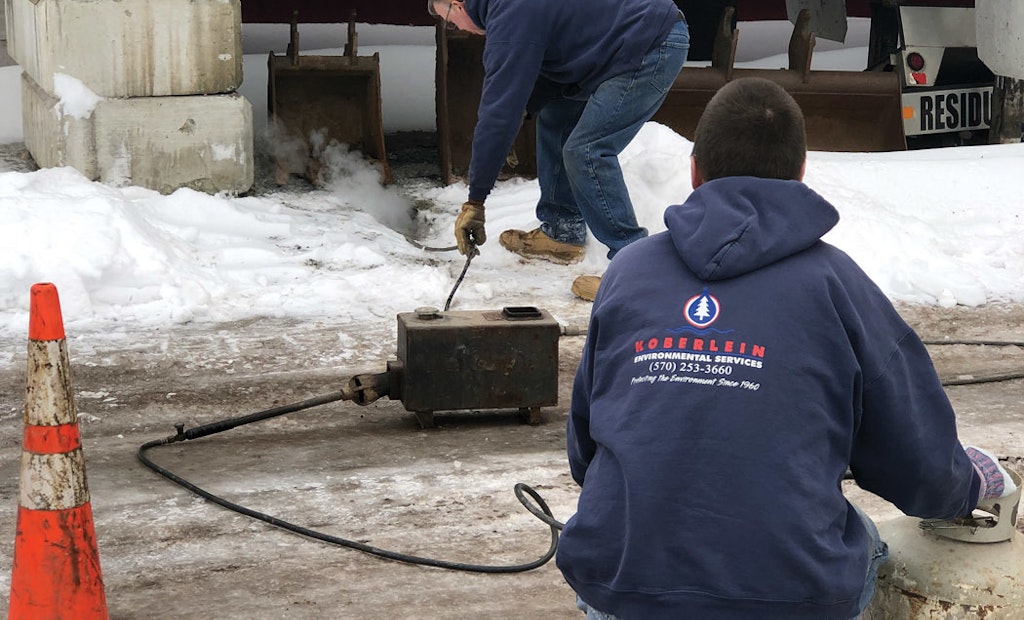
Gary Sprague, general manager at Koberlein Environmental Services, and Gene Mohrmann, operations manager, use an Arctic Blaster to thaw out a 4-inch drainline at a business in Honesdale, Pennsylvania.
When Gary Sprague first saw the Arctic Blaster more than a decade ago, he was intrigued by the premise behind it: Using pressurized steam to thaw frozen pipes. After technicians tried out the machine, the general manager at Koberlein Environmental Services in Honesdale, Pennsylvania, was more than intrigued.
In fact, Koberlein Environmental Services now owns five Arctic Blasters, a testament to their pipe-thawing ability. The company — which does everything from cleaning drain and sewer lines to pumping septic tanks and grease traps in northeastern Pennsylvania and southwestern New York — still uses water jetters and cable drain machines to clear frozen pipes. But the Arctic Blasters remain as a preferred option in certain applications, he says.
“We saw one at a trade show in 2002 and wanted to give it a try,” recalls Sprague, who’s been with Koberlein Environmental Services since 1985. “Before that, we only used a sewer rooter or a water jetter, but they weren’t always effective.
“After we bought it, it took a little bit to understand exactly where and how to use it,” he says. “But we were impressed. Now it’s one of our main tools for thawing frozen lines. We’ve found that it’s an excellent tool for providing great service in the communities we serve — helps out homeowners who are in bad situations.”
Technicians at the company, which employs about 50 people and was established in 1960, use the Arctic Blaster to clean 2-, 3-, 4- and 6-inch-diameter pipelines, but mostly 3- and 4-inch sewer, water and septic system lines. One of the main benefits: The Arctic Blaster doesn’t use highly pressurized water to carve through ice the way a water jetter does. That enables employees to use it in places where it’s not a good idea to disperse hundreds of gallons of water.
“If you have to work in a basement with a water jetter, for example, you’d be dumping a lot of water on the floor,” Sprague says. “This is a much cleaner way to thaw pipes.”
The Arctic Blaster weighs about 70 pounds and measures 16 inches long by 7 inches wide and 11 inches tall. It’s basically a water-boiling unit that uses a lit propane torch to heat water. (The propane torch and tank must be bought separately.)
To use it, operators must first fill the unit with about 2 gallons of water; that’s enough to produce about 15 minutes of steam. Then they need to attach one of the two single-braid hydraulic hoses that come with the device: a 3/8-inch-diameter hose designed for thawing larger-diameter pipes and a 1/4-inch-diameter hose for smaller-diameter pipes. Both hoses include a quick-coupler connection and are rated for up to 3,000 psi.
Next, operators light the torch and place it inside the unit’s so-called fire tube on the rear of the machine. When steam comes out of the end of the hose, the device is ready to go to work. It generally takes about five to eight minutes to heat the water to the point that it creates steam.
To start thawing, a technician inserts the hose into the frozen pipe. But be careful — the hose emits scalding-hot steam. For safety, the unit features a 16 psi pressure cap atop the water tank portion, similar to those found atop car radiators.
It’s hard to estimate how fast the Arctic Blaster can thaw out a pipeline because of variables involved, such as the length of the blockage and the diameter of the pipe. But a demonstration video on the Arctic Blaster website shows the unit thawing a 4-foot-section of completely frozen, 3/4-inch-diameter copper pipe in about two minutes. The same video shows the unit thawing a 4-foot-long section of completely frozen, 4-inch-diameter PVC pipe in about 10 minutes.
In any case, the unit’s ability to thaw out long sections of pipe isn’t in question, Sprague says, noting that on one particular job he thawed out 80 feet of an intermittently frozen pipeline. “It took a while, but the machine opened it up,” he says. “The hose moves forward in small increments, so try not to be in a hurry. Even if you think it’s not doing what you want it to do, over time, it will thaw out the line.”
The Arctic Blaster is easy to use so the learning curve for operating it is short. Moreover, while the thought of working with a lit propane torch might concern some contractors, Sprague says he’s never felt unsafe operating one. Operators just need to use common sense, he says.
Overall, the Arctic Blasters have proven to be a valuable asset to the company and have provided a good return on investment, Sprague says. “We wouldn’t keep buying them if they weren’t getting the job done and providing a good service for our customers.”





